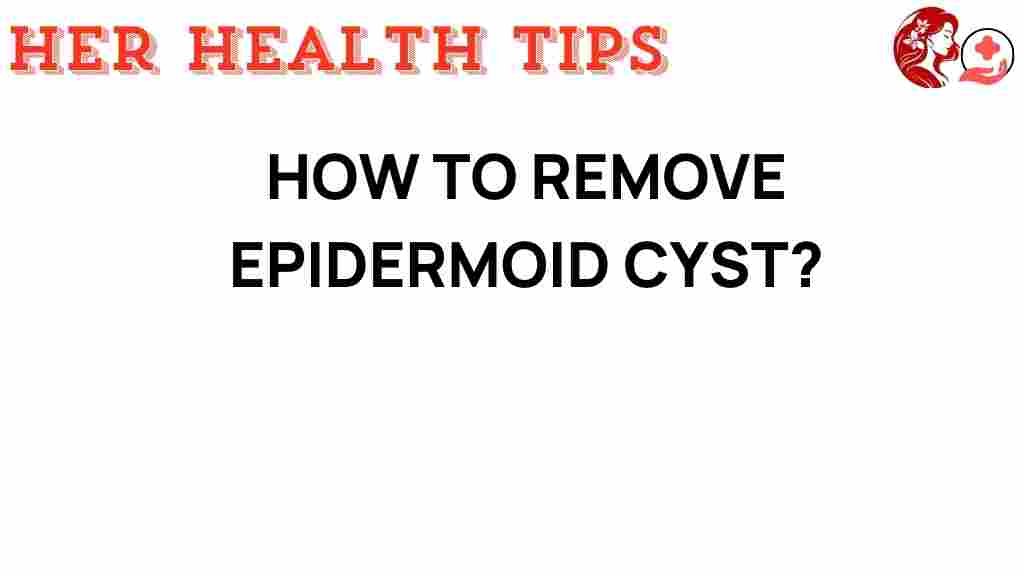Unveiling the Secrets: How to Remove Epidermoid Cysts Safely
Epidermoid cysts are common, non-cancerous growths that can appear on the skin. These small, usually painless lumps can cause concern for many individuals, primarily due to their appearance. Understanding the various removal methods, treatment options, and the importance of skin health can help you manage these cysts effectively. In this comprehensive guide, we will explore everything you need to know about epidermoid cysts, from surgical procedures to at-home remedies and essential dermatologist advice.
What is an Epidermoid Cyst?
An epidermoid cyst, often mistakenly referred to as a sebaceous cyst, is a small, round bump beneath the skin. It is formed when skin cells multiply and become trapped under the skin’s surface, leading to a fluid-filled sac. These cysts can occur anywhere on the body but are most commonly found on the face, neck, and trunk.
Although epidermoid cysts are generally harmless and asymptomatic, they can become inflamed or infected, leading to discomfort and a desire for removal. Understanding your options for cyst care is essential for maintaining optimal skin health.
Why Remove Epidermoid Cysts?
While many choose to leave epidermoid cysts untreated, there are valid reasons to consider removal:
- Aesthetic concerns: Many individuals seek removal for cosmetic reasons, especially if the cyst is located on a visible area of the body.
- Discomfort: If the cyst becomes large or inflamed, it can cause discomfort or pain.
- Infection risk: An infected cyst may require prompt removal to prevent further complications.
Exploring Removal Methods for Epidermoid Cysts
When it comes to removing epidermoid cysts, there are several methods to consider. Each option varies in effectiveness, recovery time, and suitability depending on the individual case.
Surgical Procedures
Surgical removal is the most effective method for eliminating epidermoid cysts completely. It involves a minor outpatient procedure where a dermatologist or surgeon:
- Prepares the area: The skin is cleaned, and a local anesthetic is administered to numb the area.
- Incises the cyst: A small incision is made over the cyst, allowing for its removal.
- Drains the cyst: The contents are carefully drained, and the cyst sac is removed to prevent recurrence.
- Closes the incision: The incision is stitched up, and a bandage is applied.
This method is often preferred because it minimizes the chance of recurrence and ensures complete removal. Post-surgery, it’s crucial to follow dermatologist advice for proper wound care.
At-Home Remedies
While surgical removal is the most effective way to eliminate epidermoid cysts, some individuals may explore at-home remedies for minor cysts. However, it’s important to approach these methods with caution. Here are some common at-home options:
- Warm compress: Applying a warm compress can soothe discomfort and may help the cyst drain on its own.
- Tea tree oil: Known for its antibacterial properties, tea tree oil may help reduce inflammation and prevent infection.
- Apple cider vinegar: Some believe that applying diluted apple cider vinegar can help shrink cysts over time.
Always consult with a healthcare professional before attempting at-home treatments to ensure they are safe for your specific situation.
Dermatologist Advice on Epidermoid Cysts
For anyone dealing with epidermoid cysts, seeking advice from a dermatologist is crucial. They can provide expert guidance on:
- Diagnosis: Ensuring the lump is indeed an epidermoid cyst and not another type of growth.
- Removal options: Discussing the best methods for removal based on the cyst’s size and location.
- Post-removal care: Providing instructions for caring for the site post-procedure to prevent infection and promote healing.
For more information on finding a qualified dermatologist, visit this resource.
Step-by-Step Process for Safe Epidermoid Cyst Removal
Here’s a detailed step-by-step process for those considering cyst removal, whether at home or through professional treatment:
Step 1: Assessment
Before making any decisions, assess the cyst:
- Is it painful or inflamed?
- Has it changed in size or color?
- Is it affecting your quality of life?
Step 2: Consult a Dermatologist
Schedule an appointment with a dermatologist. They will evaluate the cyst and recommend the best course of action.
Step 3: Decide on a Removal Method
Based on the dermatologist’s advice, decide whether to:
- Proceed with surgical removal.
- Try at-home remedies if the cyst is small and non-problematic.
Step 4: Prepare for Removal
If opting for surgical removal:
- Follow pre-surgery instructions, such as avoiding blood thinners.
- Arrange for transportation if sedation is involved.
Step 5: Follow Post-Care Instructions
After removal, follow these care tips:
- Keep the area clean and dry.
- Change dressings as instructed.
- Watch for signs of infection, such as increased redness, swelling, or discharge.
Troubleshooting Tips for Epidermoid Cyst Care
Even with proper care, some individuals may experience issues with their cysts. Here are some troubleshooting tips:
- Infection: If you notice increased pain, swelling, or pus, contact your dermatologist immediately.
- Recurrence: If the cyst reappears, discuss further treatment options with your dermatologist.
- Skin irritation: Avoid excessive rubbing or irritation of the area to promote healing.
Conclusion
Removing epidermoid cysts can be a straightforward process with the right knowledge and resources. Whether you choose surgical procedures or explore at-home remedies, understanding your options is essential for maintaining proper skin health. Always consult with a dermatologist for tailored advice and to ensure safe and effective removal. Remember, cyst care is vital for preventing complications and promoting overall skin wellness.
For more detailed insights on skin conditions and treatments, consider visiting this external resource.
This article is in the category Conditions and created by HerHealthTips Team

1 thought on “Unveiling the Secrets: How to Remove Epidermoid Cysts Safely”